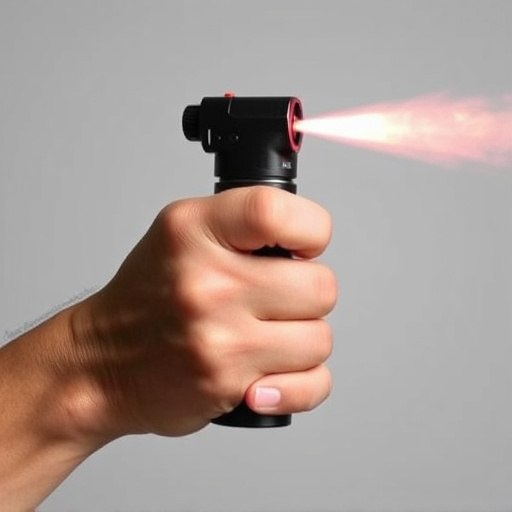“Unleashing control in chaotic situations, inflammatory riot control spray dispensers stand as powerful tools for law enforcement. This article delves into the intricate world of military-grade pepper spray formulas, exploring their science and effectiveness. We dissect the key components that make these sprays potent crowd control agents, highlighting their applications and safety measures. From understanding complex formulations to ethical considerations, this guide offers a comprehensive overview of how military-grade pepper spray is reshaping riot management.”
- Understanding Military-Grade Pepper Spray Formulas: An Overview
- The Science Behind Inflammatory Riot Control Sprays
- Key Components and Their Efficacy in Crowd Control
- Applications: When and Where to Deploy These Dispensers
- Safety Measures and Ethical Considerations for Use
Understanding Military-Grade Pepper Spray Formulas: An Overview
Military-grade pepper spray formulations are designed with utmost potency and effectiveness in mind, often employing complex chemical compositions to achieve their powerful irritant properties. These formulas typically contain capsaicin, a natural compound derived from chili peppers, as the active ingredient. The concentration of capsaicin can vary significantly, ranging from 1% to 20%, determining the spray’s intensity and impact.
Beyond capsaicin, military-grade pepper sprays may incorporate additional agents like thermogenics, which enhance the burning sensation, and various stabilizers and preservatives to ensure longevity and performance under diverse conditions. The formulations are rigorously tested for safety, toxicity, and consistency, adhering to strict military standards. This ensures that each spray delivers a precise and controlled dose of irritants, providing personnel with a powerful tool for riot control while minimizing collateral damage or long-term harm.
The Science Behind Inflammatory Riot Control Sprays
The science behind inflammatory riot control sprays involves a deep understanding of chemical compounds and their effects on the human body, specifically the eyes, skin, and respiratory system. These specialized products are designed to disrupt and incapacitate individuals involved in civil unrest or violent demonstrations through an array of active ingredients. Military-grade pepper spray formulas, for instance, leverage capsaicin, the compound responsible for the heat sensation in chili peppers, to induce a burning sensation and temporary blindness when sprayed directly onto the face and eyes.
Researchers and manufacturers continuously refine these formulations, balancing potency with safety, to ensure effectiveness without causing severe or long-lasting harm. Modern riot control sprays may also include other irritants like oleoresin capsicum (OC) and chemical agents like chloroacetic acid, which can disrupt communication and coordination among rioters, providing critical time for law enforcement to restore order.
Key Components and Their Efficacy in Crowd Control
Applications: When and Where to Deploy These Dispensers
In various tactical scenarios, inflammatory riot control spray dispensers prove invaluable. These devices are particularly useful for law enforcement agencies and security forces dealing with civil unrest, mass gatherings, or high-risk security operations. The primary application lies in crowd control, where a quick deployment of these dispensers can effectively disrupt and dissipate unruly crowds.
When faced with violent riots or potential threats at large events like protests, sports matches, or festivals, these dispensers offer a non-lethal yet powerful deterrent. Military-grade pepper spray formulas used in these devices provide a safe and controlled way to neutralize agitators without causing permanent harm. Their portability and ease of use make them suitable for both indoor and outdoor settings, ensuring that authorities are well-equipped to maintain public safety and order efficiently.
Safety Measures and Ethical Considerations for Use
When it comes to safety measures and ethical considerations for using inflammatory riot control spray dispensers, several key points must be addressed. These powerful tools, often employed by law enforcement and security personnel, utilize military-grade pepper spray formulas designed to incapacitate individuals temporarily through irritation of the eyes, nose, and respiratory system. However, their use raises significant concerns regarding public safety and civil liberties.
Proper training is indispensable for operators to ensure accurate targeting and minimize off-target effects, which can cause harm to bystanders or innocent individuals. Ethical guidelines should also be in place to govern the circumstances under which these devices may be deployed, balancing the need for crowd control with potential risks to public health and safety. Additionally, regular maintenance and inspection of equipment are crucial to guarantee their reliability and prevent accidental discharge or misuse.
Military-grade pepper spray formulas have evolved significantly, becoming powerful tools in riot control. Understanding their science, key components, and safety measures is crucial for effective deployment in managing crowds. These dispensers offer a tactical advantage, but ethical considerations must be taken seriously to ensure responsible use. By considering the right applications and adhering to strict guidelines, law enforcement agencies can leverage these innovative formulations to maintain public safety while respecting human rights.
